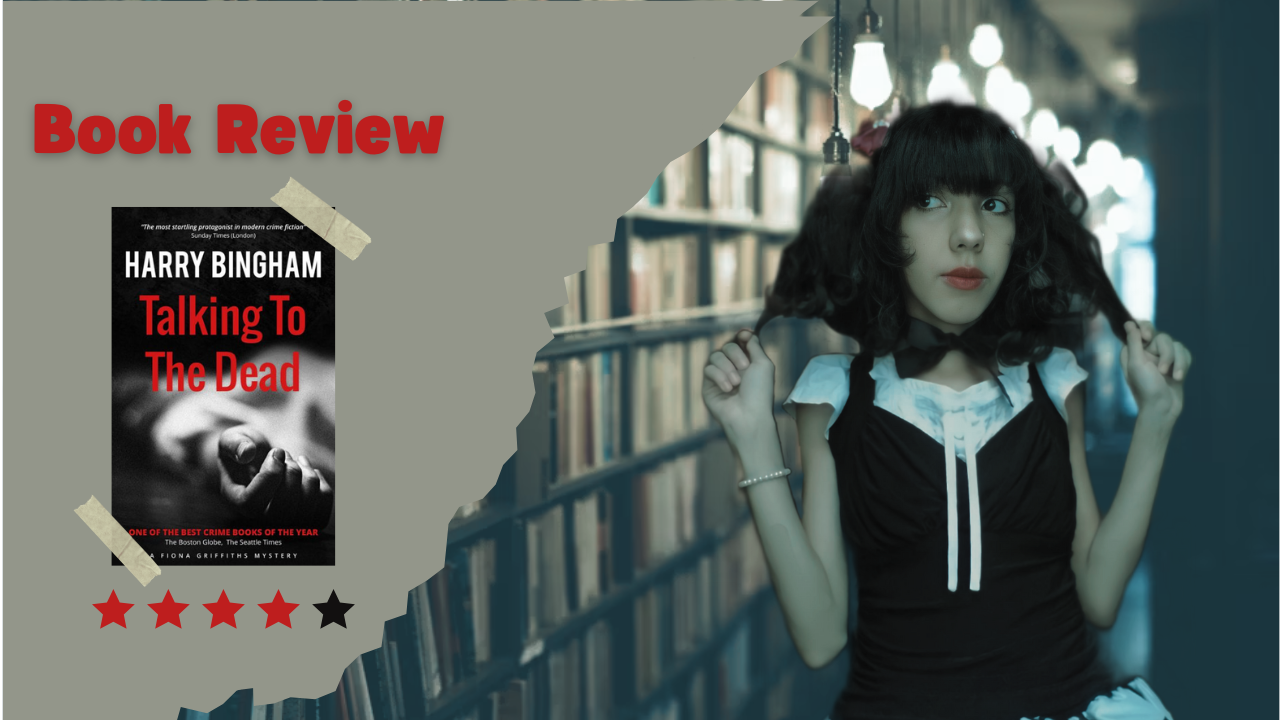

English


Set in Cardiff, described in a gloomy way, where we are able to see the dark side of the streets and the most vulnerable population... "Talking to the Dead" is a crime novel that puts us in the mind of Fiona Griffiths, a rookie cop, whose first investigation is quite crude: a young prostitute and her daughter were murdered in an abandoned house.
Although for the others everything seems to point to the fact that the woman met the wrong client, our protagonist is sure that something deeper is at stake and is willing to go to great lengths to find out what it is.
However, a very helpful tool in this investigation is that Fiona is not like other detectives, she has the strange ability to "talk" with the dead, which will end up causing a twist not only to the investigation, but to her own life.

Opinion


On the other hand, we can also talk about her ability to speak with the dead. To begin with, Fiona allows us to see the dead in a more human way. Where to another person they might be somewhat grim or even frightening, Fiona comes to admire them. For example, in our first glimpse of the case of the prostitute and her daughter, Janet and April, we are shown that Fiona comes to see a smile on April's face, even though April is dead and that smile is a product of muscle tension, she sees something more human. Also, later in the story, she is able to "share time" with other dead people, with Janet and, especially, April being the ones she feels strongly connected to. It's quite interesting the approach we are given, where Fiona doesn't explicitly "talk" to the dead, but feels a connection to them where she can know a bit about what they are like, what vibes she gets from them, what personalities they have and even what feelings they have. This is an element that made me wonder if the morgue workers feel the same way.

Fiona is a different character to what I have seen, but it is one that is quite endearing and one that I even admire, because she gave her all, going above and beyond her boss orders and even putting herself in great danger, to unravel the mystery that the investigation entailed. She is a character that one probably won't connect with, as she is very unhuman, so to speak, due to the fact that she is not capable of feeling emotions and it is even mentioned on several occasions that she is not capable of crying. She is quite an interesting character to get to know and one that I grew quite fond of, even though she is a bit of a "weirdo".

One element that made me read the story was the fact that they took a rather rare psychological illness for inspiration, which is Cotard's syndrome. Which, according to the final pages of the book, is a rare, but authentic disorder. It is a serious illness, starring depression and psychosis. According to modern psychiatrists, it is not a disease per se, but a representation of depersonalization in its most extreme form, where early childhood trauma is usually a common factor in almost all documented cases. The sad fact is that a full recovery is rare, and suicides are a common occurrence in these patients. The author was inspired by a patient of his wife. A patient who unfortunately met this sad fate.
In the novel this syndrome is reflected as, simply, feeling that you are dead, not being able to feel your body or feel emotions. A syndrome that was undoubtedly very interesting to know, but that I would never want to live. It is important to clarify that this novel represents this syndrome from a fictional point of view, which should not be romanticized or taken as something realistic.

What I didn't like about this story is that the pace can be slow, although I don't think it's bad, since it's about the course of a police investigation, but it did get boring at times; it even took me a semester of college to read the book (yes, I read in my free hours, which could be a couple). And despite this, the story at the end left me wanting a little more. Mind you, the novel has an ending that feels liberating, it fills your heart. To me it gave me a warm feeling, it felt poignant to see the road travelled. Knowing where the inspiration for this novel came from, it's nice to have an ending like that, it's like a glimmer of hope in that horrible world that must be living with this disorder, but sadly, you have to remember that it's just mere fiction.

Finally, "Talking to the Dead" is a novel that I recommend if you like crime thrillers, or if you are as passionate about psychology as I am. A fascinating story that will give you an intriguing vibe from the first moment you start your journey into the dark streets of Cardiff.
 Photo by Elyse Chia in Unsplash
Photo by Elyse Chia in Unsplash


Español


Ambientada en Cardiff, descrito de una forma lúgubre, donde somos capaces de ver el lado oscuro de las calles y de la población más vulnerable… “Hablando con los muertos” es una novela negra que nos pone en la mente de Fiona Griffiths, una policía novata, cuya primera investigación resulta bastante cruda: una joven prostituta y su hija fueron asesinadas en una casa abandonada.
Aunque para los demás todo parece apuntar que aquella mujer se topó con el cliente equivocado, nuestra protagonista está segura de que se trata de algo más profundo y está dispuesta a hacer hasta lo imposible a descubrir qué es.
Sin embargo, una herramienta de gran ayuda en esta investigación es que Fiona no es como los demás detectives, sino que ella tiene la extraña habilidad de “hablar” con los muertos, lo cual le terminará dando un giro no solo a la investigación, sino a su propia vida.

Opinión


Por otro lado, también podemos hablar de su habilidad de hablar con los muertos. Para empezar, Fiona nos permite ver a los muertos de una forma más humana. Cuando para otra persona podría ser algo lúgubre o hasta aterrador, Fiona los llega a admirar. Por ejemplo, en nuestro primer vistazo del caso de la prostituta y su hija, Janet y April, se nos muestra que Fiona llega a ver una sonrisa en el rostro de April, aunque esta esté muerta y esa sonrisa sea producto de una tensión de los músculos, ella ve algo más humano. También, más adelante en la historia, ella es capaz de “compartir tiempo” con otros muertos, siendo Janet y, sobre todo, April con las que se siente fuertemente conectada. Es bastante interesante el enfoque que se nos da, donde Fiona no “habla” explícitamente con los muertos, sino que siente una conexión a ellos donde puede saber un poco sobre como son, qué vibras les da, que personalidades tienen e incluso qué sentimientos tienen. Esto es un elemento que me hizo preguntarme si los trabajadores de las morgues se sentirán de igual manera.

Fiona es un personaje diferente a lo que he visto, pero es uno bastante entrañable y que incluso admiro, porque dio todo de sí, pasando por encima de las órdenes de su jefe e incluso poniéndose en gran peligro, para desenredar el misterio que suponía la investigación. Es un personaje con el que probablemente uno no conecte, ya que es muy poco humana, por así decirlo, debido a que no es capaz de sentir emociones e incluso se menciona en varias ocasiones que no es capaz de llorar. Es un personaje bastante interesante de conocer y con el que yo me llegué a encariñar, a pesar de que es un poco “rara”.

Un elemento que me hizo leer la historia fue el hecho de que tomaran una enfermedad psicológica bastante rara para inspirarse, la cual es el síndrome de Cotard. El cual, según las páginas finales del libro, es un trastorno raro, pero auténtico. Se trata de una enfermedad grave, protagonizada por la depresión y la psicosis. Según los psiquiatras modernos, no es una enfermedad en sí, sino una representación de la despersonalización en su forma más extrema, donde el trauma en la primera infancia suele ser un factor común en casi todos los casos documentados. Lo triste es que es poco usual una recuperación plena, y los suicidios son algo muy frecuente en estos pacientes. El autor tomó como inspiración a una paciente de su esposa. Paciente que lamentablemente tuvo ese triste destino.
En la novela este síndrome es reflejado como, simplemente, sentir que estás muerto, no ser capaz de sentir tu cuerpo ni de sentir emociones. Un síndrome que sin duda fue muy interesante conocer, pero que no quisiera vivir nunca. Es importante aclarar que esta novela representa este síndrome desde un punto de vista ficticio, el cual no se debe romantizar ni tomar como algo realista.

Lo que no me gustó de esta historia es que el ritmo puede ser lento, aunque no me parece que sea malo, ya que se trata del curso de una investigación policial, pero me llegó a aburrir en algunas ocasiones; llegando incluso a tomarme un semestre de la universidad leerme el libro (sí, yo leía en mis horas libres, que podían llegar a ser un par). Y a pesar de esto, la historia al terminar me dejó con ganas de un poco más. Eso sí, la novela tiene un final que se siente liberador, te llena el corazón. A mí me dio una sensación cálida, se sintió conmovedor ver el camino recorrido. Sabiendo de donde vino la inspiración de esta novela, es bonito tener un final así, es como un rayo de esperanza en aquel mundo tan horrible que ha de suponer vivir con este trastorno, pero que, lamentablemente, hace falta recordar que solo se trata de mera ficción.

Por último, “Hablando con los muertos” es una novela que te recomiendo si te gustan los thrillers policiacos, o si te apasiona la psicología como a mí. Una historia fascinante que te dará una vibra intrigante desde el primer momento que comiences tu camino adentrándote en las sombrías calles de Cardiff.
 Foto de Elyse Chia en Unsplash
Foto de Elyse Chia en Unsplash

English Translation | Traducción al inglés: DeepL

